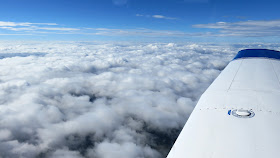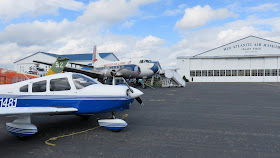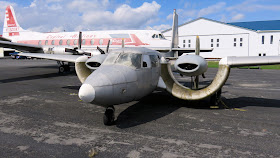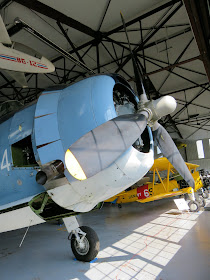"A fighter was hurtling across the sky toward them at low altitude, coming from the direction of Lingayen Gulf. Soon the aircraft was on top of them--a strange-looking plane, black as anthracite. It had a long capped snout, a swollen abdomen set with cannons, and sweeping black tails--two of them. There was a hooked needle stuck in its nose that looked vaguely like a stinger. Stair-stepping back from the cockpit was a confusing array of nacelles and bulbous Lucite housings. On the side of the nose was painted a zaftig nude in the style of Vargas, with the hand-sketched moniker Hard to Get.
Mucci smiled as the plane shot past the camp. This menacing, insectile-looking thing was, he realized, the answer to his prayers...headquarters had come through with the most impressive new fighter in the U.S. Air Force. Hard to Get was a P-61, better known as a Black Widow."
-- Ghost Soliders: The Epic Account of World War II's Greatest Rescue, Hampton Sides
Personal Day
Presented with a vacation day, beautiful fall weather, and an airplane ready to fly, I needed only to decide where to go. Mulling over the possibilities, I remembered that I had not visited the Black Widow in nine and a half years. That realization set my course.
 |
| Northrup P-61 NACA Test Aircraft, Moffett Field, California. Public domain photo (NASA) |
Black Widow was the vaguely sinister name carried by the Northrup P-61, the first purpose-built U.S. night fighter. A late World War II innovation, the unusual aircraft was called "Buck Rogers come to life", "a black barn swallow", "a
War of the Worlds rocket", and an "angel of death" by American prisoners of war whose rescue from the Japanese was foreshadowed by a nighttime aerial dance of distraction from a P-61 [1].
Yes MAAM!
I last visited the
Mid-Atlantic Air Museum in
March 2009. The facility has a modest collection of airworthy World War II aircraft. Its true claim to fame and the impetus behind its creation in 1980 is the bold effort to
restore a P-61 Black Widow recovered from a New Guinea mountainside. MAAM's Black Widow is one of only four remaining in the world. Other examples can be found on static display at the National Air and Space Museum, National Museum of the United States Air Force, and the Beijing Air and Space Museum.
Restoration has been slow, but after nearly a decade, I was curious about the progress made in resurrecting this rare World War II veteran.
Flirting with Vapor
| Date | Aircraft | Route of Flight | Time (hrs) | Total (hrs) |
| 10 Oct 2018 | N21481 | SDC (Sodus, NY) - RDG (Reading, PA) - SDC | 3.9 | 1871.5 |
At seven thousand feet, Warrior 481 raced along the base of a stratus layer floating high above Seneca Lake, at times ducking into the vapor, turning the windows gray and bringing focus to the ship's instrumentation.
 |
| Southern end of Seneca Lake |
Halfway across New York, I left the high stratus behind only to lose ground contact south of the Finger Lakes due to a low cumulus layer.
Wispy tendrils of mist streaked past my wingtip as I continued south.
Over Pennsylvania, terrain and heat worked to raise cloud tops to my cruise altitude, eventually engulfing me from below. The last forty minutes of the flight were spent in Instrument Meteorological Conditions (IMC) with occasional peeks of the aggressive Pennsylvanian terrain below.
As I bounced in and out of the clouds, I was cleared for the RNAV instrument approach procedure to runway 18 at Reading Regional Airport / Carl Spaatz Field (RDG) located about 45 nautical miles northwest of Philadelphia. I broke out around 2,500 feet, just shy of the final approach fix (which meant that I did not fly enough of the procedure to justify logging it) and made a nice landing on runway 18.
A Temporary Addition to the Menagerie
On its webpage, the MAAM advises
fly-in visitors to park on the museum ramp to avoid fees from the neighboring FBO.
I stopped next to a Bellanca Viking already parked near the museum's outdoor collection.
Clearly, only one of these aircraft is routinely hangared.
During the tour, the docent indicated that he did not know where the blue and white aircraft came from.
"That's mine," I interjected.
"Is that a Warrior?" asked the young man next to me with interest. In his late 20s, he was visiting from Columbia where he flew Airbus A320s for a local Columbian airline. He had trained in Warriors.
The docent was more interested in the Viking when I confirmed its identity. "I have never seen one before!" he exclaimed.
Weather-Beaten
MAAM has limited indoor storage. Much of the collection sits exposed outside, weather-beaten veterans slowly crumbling away. In many cases, it is not just a matter of faded cosmetics, but open windows and canopies allowing the elements access to aircraft interiors. If I had any disappointment with the MAAM, it was this.
This is a Martin 4-0-4 dubbed the "Silver Falcon". These aircraft were meant to replace tried-and-true World War II vintage DC-3s and were probably much more comfortable for passengers owing to pressurization and available air conditioning. However, the 4-0-4 appears to have been evolutionary rather than revolutionary and does not carry the respect of the DC-3 that it supplanted. This aircraft flew for Eastern Air Lines starting in 1952.
The Martin 4-0-4 featured two Pratt & Whitney R-2800 engines, once-revolutionary 18 cylinder powerplants that propelled U.S. single engine fighters to incredible speeds in the early 1940s only to be yoked in pairs to flying buses at the dawn of the jet age.
A Flying Boxcar! This was one of many new additions to the MAAM ramp since my last visit.
This Naval version of the DC-3, the R4D, was once an award winning restoration.
After too much time in the elements, however, her paint was tired and plumage tattered.
Another fading warrior, a Republic F-84 Thunderjet, struck me as looking exactly like a rocket ship should to the average American in the 1940s. The Thunderjet debuted in 1947 bearing a straight wing like those found on other early American jet fighters such as the P-80.
Its markings have faded significantly since I first saw it in 2009.
Multiple layers of laminated glass made for a bulletproof windscreen, now left open to the elements.
Even corrosion and weathering cannot hide the noble bearing of this early jet fighter.
First flown in 1945, the Lockheed P-2 Neptune with its distinctive bulbous belly dome was a patrol and surveillance aircraft. I wonder if the designer of the Neptune's landing gear went on to design the ones on my airplane, because Warrior 481 always seems a little lopsided on the ground, too.
Primarily piston-driven, the required loiter time of this patrol-craft meant that it carried heavy fuel loads aloft. As a result, the ship is equipped for jet-assisted take-off. When the docent told our tour group that both engine types ran on the same fuel, we were skeptical, but further research verifies that these jet engines were designed to run on avgas to avoid equipping the Neptune with two separate fuel systems.
 |
| Reading Tower framed by the Neptune. |
Simultaneously the ugliest and the most interesting aircraft on the ramp, the aptly-named Custer Channel Wing was designed to pull air across the wing in a way that generated lift at remarkably low airspeed, reportedly 8 - 11 mph.
A Vickers Viscount airliner sporting the colors of yet another defunct airline, Capital.
Captial grew out of Pennsylvania Central Airlines and was headquartered at Washington National Airport before being absorbed by United in 1960.
Close Quarters
Finished with the various aircraft on the ramp, we moved inside.
 |
| Instrument panel of a Northrup F-89 Scorpion, a jet fighter first introduced in 1950. |
Once inside the MAAM hangar, tight quarters are evident. This Ercoupe is squeezed beneath the empennage of the museum's B-25 Mitchell bomber.
All of the museum's airworthy aircraft are stored inside, including this immaculate Beech 18.
As on my last visit, it is hard to find good angles to photograph this burly Grumman Avenger torpedo bomber.
Whenever I look at a Grumman wing folded back for storage, I am reminded of how Roy Grumman famously worked out this skewed-axis hinge arrangement using a paperclip and an eraser.
The museum gives rides in this gorgeous Stearman Kaydet. Previously, the museum also had a nice N3N naval trainer, but it was not in evidence this time around.
An L-3, a military version of the Aeronca Champ used for liaison work and reconnaissance.
The Vultee Valiant always struck me as a wannabe SNJ/T-6 Texan designed with the wrong proportions; scrawny landing gear, too little fuselage, too much canopy.
 |
| Naval SNJ WWII advanced trainer |
Speaking of which...
MAAM flies this airworthy B-25 Mitchell bomber on the air show circuit regularly enough that I have seen it at
Geneseo before.
MAAM indicates that their B-25 is one of the most complete restorations in the world and carries all of the equipment that it would have during active duty, including a Norden bombsight.
This B-25 is also a movie star and appeared in
Catch 22.
The Main Attraction
For me, the tour ended with the P-61 Black Widow, still tucked away in the back corner as it was when I first saw it in 2009.
 |
| The Black Widow as I saw it in 2009, viewed from the rear radar-operator's position |
When I visited the museum in 2009, only the central portion of the aircraft was assembled (above). No engines, no tail booms, no tail control surfaces.
Also, there was no giant spider attached to the then-non-existent vertical stabilizer in 2009.
Today, the Black Widow looks more like an airplane. Engines are mounted and the tails are attached. The only significant portion of the structure missing are the wings outboard from the engine nacelles.
Thematically-relevant nose art is already in development. The unusual vane projecting laterally from the fuselage is a side-viewing radar meant to add some peripheral vision to the large dish in the nose. Radar is what differentiates night fighters from day fighters. Early experiments with aerial radar involved hanging a pod beneath the right wing of singe engine fighters (commonly Hellcats, but MAAM's Avenger has one). Understandably, this made for lousy flight characteristics. Placing the primary radar in the nose of a twin-engine aircraft cleans up the balance and aerodynamics of the ship considerably.
Deciding that I was sufficiently airplane-savvy to avoid hurting myself, the docent allowed me to climb a step-ladder into the cockpit. To put it mildly, there is more work to do. Then again, the last time a pilot took the controls in this cockpit was 1945 and the aircraft has crashed into a mountain since.
Looking back toward the tail of the aircraft from the cockpit, a circular opening in the top of the fuselage is apparent where the top turret was/will be located.
One of the Black Widow's two Pratt & Whitney R-2800 engines.
The tail end of the fuselage is now fully enclosed and ensconced between twin tail booms.
It was quite exciting to see so much progress accomplished on the restoration. Will it ever fly again? The museum hopes so. Only time will tell.
Dinner Date
Despite a large, late morning breakfast, I was famished when I finished my tour of the museum. The previous restaurant on the field, Malibooz, has since been replaced by
Klinger's. The restaurant has good reviews (both on-line and per folks at the museum), but I had a dinner date in Rochester and no time to dawdle.
I walked to the neighboring flight school thinking that it looked like the sort of place that would have snacks available. It was. After devouring a package of peanuts, I called for my clearance and returned to the air.
It was a beautiful flight home and, best of all, I was actually on time for dinner. Aviation for the win!
Overall, visiting the Mid-Atlantic Air Museum is a mixed bag. Airworthy aircraft in the collection are well-maintained and the Black Widow project, despite its glacial progress, demonstrates excellent craftsmanship and attention to detail. In my opinion, these strengths of the museum are offset by deterioration of artifacts on the ramp, past restorations now in retrograde. I am certain that the museum would have all of these aircraft under cover if it had the means, but the sad truth is that they are woefully exposed.
Someday, I hope to see the Black Widow in the sky and know that I spent a moment in the cockpit during its reconstruction.
Endnote
1. "To the men of Cabanatuan, the plane, whatever it was, seemed a powerful, almost eerie emblem of how far American technology had evolved in the three years of their captivity. Mechanically, logistically, conceptually, this was a different Army. On Bataan, they'd starved in their shallow metal helmets fighting old-fashioned pitched battles with dud shells and rusty artillery. Thirty-odd months later, they had only to gaze upon this sci-fi lozenge streaking through the clouds at 300 miles per hour to understand that everything, the whole social and industrial universe back home, had changed."
Excerpted from
Ghost Soliders: The Epic Account of World War II's Greatest Rescue by Hampton Sides. Though the Black Widow only played a brief, if memorable, role in Ghost Soldiers, the book is highly recommended for anyone interested in WWII history and the war in the Pacific. It is well-researched and beautifully written.































































































